Animals to survey for the corridors project
We will be conducting both standardised and opportunistic surveys in 2020 and then in subsequent yeas to monitor our progress.
Where are the priority areas for surveys?
Especially for the standardised surveys, we want these in the hubs: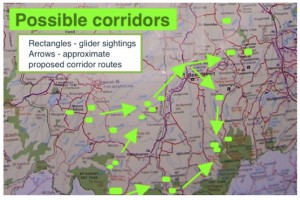
- Kooralbyn / Round Mountain
- Mount Alford / Dugndan area
- Birnam Range area
- Mt Maroon / Rathdowney / Knapps Peak area
- Lower Duck Creek area of Kerry Valley
and in the corridor routes between:
- Kooralbyn and Mount Alford
- Kooralbyn and Knapps Peak
- Round Mountain and Birnam
- Birnam and Duck Creek
We may look later at a corridor route along the border from Palen Creek through Running Creek Valley, so observations there would still be relevant. We’re looking first at the central areas of the Scenic Rim as they are less well protected.
We were hoping to get as many of these done as possible by the end of
May, and then repeat Sep-November, but the coronavirus crisis has interfered with many plans
Still, if you’re able to do any of these in your backyard or somewhere nearby (you would be exercising, which I think is a legitimate reason to venture a little further while still social distancing, please let Ronda (chair) know your intentions and then send the results to scenicrim@wildlife.org.au
Scroll down for animals we’re especially focusing on, and for a survey sheet that can be used on tablets etc. or printed out.
Plans for surveys
- 30-minute surveys in three time periods for each of about 50 sites: morning (in first 3 hours after dawn), afternoon (in last 3 hours before dusk) and evening (in first two hours after dusk).
- Any further opportunistic sightings or extended surveys, day or night, not to be used in quantitative analyses of differences, but the information still to be used qualitatively to give a broader view of what species are using the habitat areas we are surveying
- Recordings of what plants gliders are feeding in, and. whether they appear to be eating insects, flowers, fruits, sap or gum, either during the standard surveys or any opportunistic sightings at other times
- Recordings of which native bees, butterflies or moths are seen visiting which flowers (with photos if possible). If you can’t identify the bee or butterfly, take a photo or with a description: there will of course be some we will never identify to species level, but we can still collect quite a bit of useful information to guide future plans. Visits of any species to fruits are also of interest.
- Focussing a motion-sensing camera on a medium to large sized eucalyptus trunk, from about 2 or 3 metres away, with honey-water mixture sprays or dabbed at about eye level or slightly higher, leaving this out for four nights (and possibly replenishing the honey-water), then moving it so that for the next four nights it points towards the ground, again about 2 to 3 metres away, with small amount of rolled oats mixed with honey and peanut butter, plus a piece of sardine and a few pony pellets or macropod pellets, to see what ground-forging animals you may attract. It would be especially useful if when first setting the camera up you could hold a sign in front of it give location and date. When positioning cameras, always try to do it in an inconspicuous spot – cameras have been. stolen. I usually then make a photo of the camera’ position with my phone, as I have been known to hide cameras so well it’s taken me a few hours to find them again. If you’ve never used a motion-sensing camera before, we’ll do the first bit with you. Please note this is NOT a good way to feed the animals, just a tiny bit to be used to attract them temporally to the cameras for our surveys.
We do want as much information as possible on all animals, but some are more relevant than others in terms of needing corridors.
We’re asking all volunteers to familiarise themselves especially with the following species, which are included in the first section of our survey sheets:
Squirrel glider
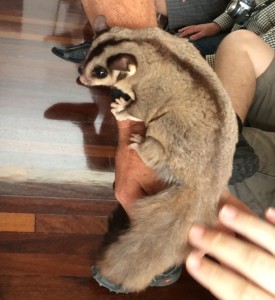
Squirrel glider showing the very bushy tail
It was our surveys of this species that led to the wildlife corridor project, as they prefer the lower-altitude, drier, more. open forests, such as those of the central areas of the Scenic Rim.
There is only one other glider in the area that could be confused with them – the sugar glider
Identifying the squirrel glider:
- slightly larger than the sugar glider (difficult to tell when seen from a distance or in surroundings you’re not familiar with)
- slightly longer nose (again difficult – easier if you can get a profile photo)
-
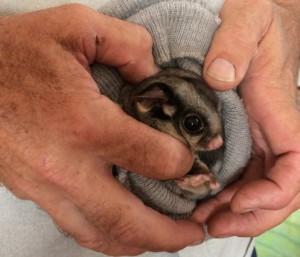
Sugar glider, showing the snub nose (compare with squirrel glider’s slightly longer nose)
very thick bushy tail, much broader at the base (where it leaves the body) than that of the sugar
- never has a white tip to the tail (not all sugar gliders have this, so absence
of a white tip doesn’t immediately click it as squirrel, but if it does have a white tip it is definitely sugar.
We do want recordings of sugar and other gliders as well, but the squirrel glider features in the first section of our survey sheet, as it is one of the main ones we are interested in studying (the other gliders mostly prefer the tall dense mountain forests, which are better protected). The other glider most likely to be present in the places we’re surveying is the tiny feathertail glider (hard to spot because of its size).
Koala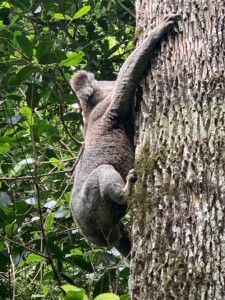
No one should mistake a koala for anything else, but it pas to look carefully. National parks sometimes get koalas reported the turn out to be brush tail possums, because the observer has just seen the thick grey hair and jumped to the wrong conclusion.
Signs that koalas have been around are:
- strong parallel scratch marks on smooth-barked trunks (from he two thumbs)
- roughly football shaped droppings that smell of eucalyptus
Rufous Bettong
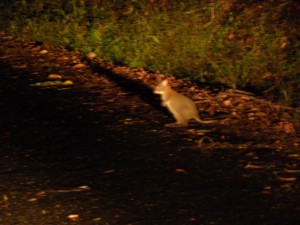
Rufous-bettong
Not often seen, because of its small size and strictly nocturnal habitat, these are tiny (rabbit-sized) relatives of kangaroos, smaller than pademelons and more closely related to potoroos. Pademelons, as well as being a bit larger, are plumper and have slightly longer arms. Potoroos have slightly longer noses, and their faces are more bandicoot-like than bettong faces. Try for a photo if possible.
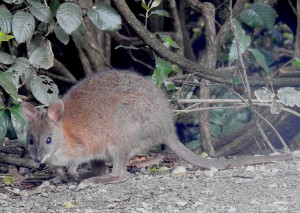
Pademelon, showing plumper body than bettong
They often leave little conical holes in the ground similar to bandicoots, where they have been digging for fungi, tubers and roots of small plants. They also eat grass and other small plants.
They are not rare, but not as common as some of our wallabies, and although they do well in grassy areas for food they also need shelter for their day-time siestas, and although their short legs can carry them 4km or so during the night they can’t travel as far or as fast as wallabies can between habitat patches, so would be a good indicator of whether our plantings of shrubs under eucalypts help them over the next few years. If it helps them it is probably also helping other small creatures such as antechinus and various lizards.
Bandicoots
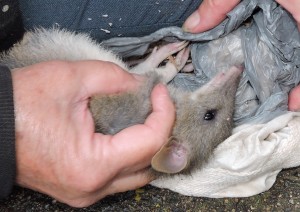
Bandicoot
It may be difficult to tell if you are looking at a northern brown bandicoot, but they both need low vegetation for shelter, so again will be a good indication of whether our corridors are becoming suitable, at least in some stretches, for those and other small creatures that need similar shelter.
They don’t hop on two legs like bettongs, but bound along more like rabbits.
Echidna
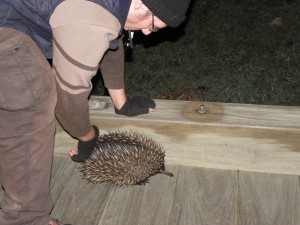
Darren helping an echidna safely off a bridge in Kerry Valley (that’s not a cigarette by the way)
Yet another mammal that needs low vegetation or at least logs and boulders for shelter, but they are otherwise quite tolerant of different habitats as long as they have enough termites or ants to eat.
Glossy black cockatoo
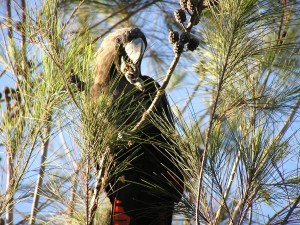 We’re including these as a vulnerable species with a specialised diet – in our district very dependent on the seeds of Allocasuarina torulosa, some of which we’ll be planting along the corridors.
We’re including these as a vulnerable species with a specialised diet – in our district very dependent on the seeds of Allocasuarina torulosa, some of which we’ll be planting along the corridors.
The red tail distinguishes the, immediately fro the more common yellow-tailed black cockatoo. It would pay to look in a bird book to familiarise yourself with the differences between glossies and red-tailed cockatoos, but you’re actually more likely to see glossies in our region.
Grey-crowned babbler
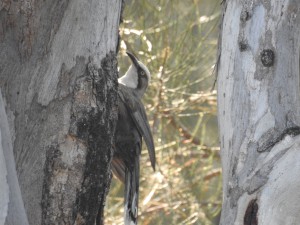
Grey-crowned babbler
The populations of these ground-foraging bird have been diminishing throughout their range. We’ve still been seeing them nerf Rathdowney and in Kooralbyn. It’s quite distinctive, not only for the curved bill and face markings, but for their noisy communications with each other as small groups hop along the ground searching for insects, sometimes also taking insects from tree-trunks.
Superb fairywren
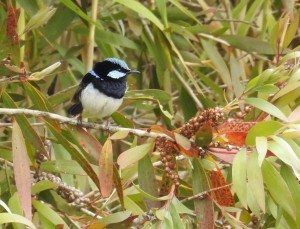
Fairy-wrens usually disappear from areas where understory is destroyed
We’re including this one as yet another small species dependent on low vegetation cover, and an easily-reconisable one. It doesn’t do well in over-grazed or frequently-burnt areas with only trees and short grass.
The female is brown with orange on the face new the bill and the eye (faces of female red-backed fairy-wrens are duller). Variegated fairy-wrens are similar, but have a rich chestnut patch on the shoulders.
Striped honeyeater
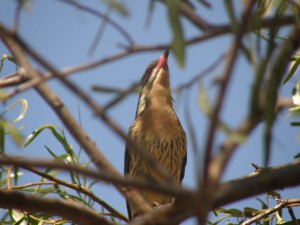
Striped_Honeyeater
We’d like all honeyeaters noted, but have included this one here as it is one of the less common ones, and one that lives in drier woodlands and also in riparian sheoak areas, both of which are features of our region, and has been recorded in the Kooralbyn / Round Mountain area.
Bearded Dragon
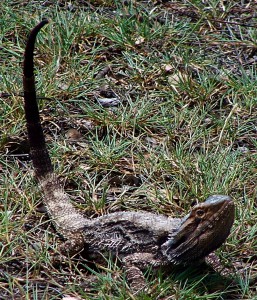
Bearded Dragon
There are other lizards that probably need corridors more than these do but we’ve included this species as it is easily recognisable and found in many parts of our region, but don’t seem to be as common as they were a few years ago.
Blue-banded bee
These are solitary bees about the size of European honeybees, but the abdomen is attractively banded in blue and black.
They are import o some flowers in providing “buzz pollination”, where they grip he flower and vibrate their flight muscles in a way that releases he pollen.
https://www.aussiebee.com.au/blue-banded-bee-information.html
Sugarbag (stingless) bees
These look a first sight more like and than bees.
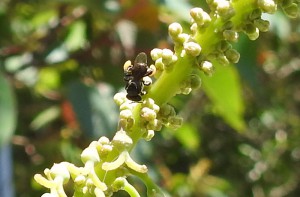
They are colonial, like honey bees, and produce quite a delicious honey but not in large quantities.
There are a number of species of these, and many other species of naive bee. Try to take a photo if you can, where possible showing what kind of flower they are visiting.
All birds, mammals, reptiles, frogs, butterflies, native bees are of interest, to be recorded where possible on the lower part of the sheet, and also photographed where possible. Christmas beetles, longicorn beetles and others could also be noted, but don’t feel you need to make a massive list to be useful. Concentrate on looking for the ones mentioned above, then add others if you can. A compilation of all records from throughout our hubs and corridor routes will still help us in monitoring our progress over the next few years.
You can download surveys sheets here and either print them out, use on a phone, able or computer during he survey, or take notes by hand during he survey and ASAP (before memory of details fade) transfer to sheets on he computer. Whichever way you record your observations, please send electronic copies of filled-in sheets to scenicrim@wildlife.org.au
Fauna survey sheet – corridors (pdf)
I tried to upload an Excel version, but received a message that it is not permitted. You can use “Annotate” and “text” to write on a pdf, or you could email me and ask me to send an Excel version.
Many thanks to all participants!




